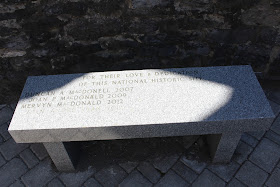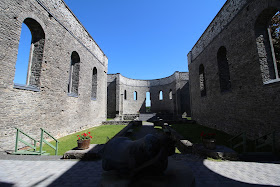"Across the Heart of Glengarry some miles inland from the St. Lawrence, the historic King's Road runs east and west along the highlands. This high road, named for King George III, is an inverted riverbed left behind by a decaying glacier. Its broad sloped back has felt aboriginal moccasins, borne the cannons of war, and witnessed the rise of a nation..."
"Au cœur de Glengarry, dans les terres à quelques miles du Saint-Laurent, l'historique chemin du Roi longe les highlands d'est en ouest. Cette route bombée nommée en l'honneur du roi George III, fut formée par le recul du glacier. Cette chaussée a vu passer les moccassins des autochtones et les cannons en plus d'avoir été témoin de l'essor d'une nation..."
"From the edge of old Quebec, crossing over the Military Road at Sandfield's Corners (the "Brown House) and through Indian Lands on the western boundary of Glengarry, the King's Road runs past one of the most imposing historic structures in Eastern Canada. Begun on the eve of Waterloo, the majestic walls fo the church of St. Raphael's overlook the green fields below.
"These silent walls proclaim the dignity of our ancestors. The harmony of the place is that of Highland people: gentle in peace, fearsome in battle.
"But why here? And what manner of men and women were these settlers of St. Raphael's?"
"Près de l'ancien Québec, croisant Military Road à Sanfield's Corners (« Brown House ») et passant par les terres indiennes sur la frontière ouest de Glengarry, le chemin du Roi défile devant une des structures historique le plus imposantes de l'Est du Canada. Amorcés la veille de la bataille de Waterloo, les murs majesteux de l'église de Saint-Raphaël surplombent les verts pàturages.
"Cette enceine silencieuse annonce la dignité de nos ancètres. L'harmonie de lieu reflète celle du peuple des Highlands : doux en temps de paix, redoutable au combat.
"Pourquoi ici? Et qui étaient ces colonisateurs de Saint-Raphaël?"
"They were the sons and daughters of the clans who were defeated with Bonnie Prince Charlie at Culloden, of the loyal Scots from the Mohawk Valley of New York, and of the Glengarry Fencibles of the Irish Rebellion of 1778 and of those who rallied to the fiery cross in the war of 1812.
"Regrettably, the great St. Raphael's Church burned in August 1970 leaving only the majestic walls remaining."
"Ils étaient des fils et des filles des clans défaits à Culloden avec Bonnie Prince Charlie, des Écossais loyaux de la vallée Mohawk de New York ainsi que des soldats Glengarry Fencibles lors de la rébellion irlandaise de 1798 et ceux qui se rassemblaient sous la croix de feus lors de la guerre 1812.
"En août 1970, un incendie détruisit la magnifique église de Saint-Raphaël ne laissant que les murs."
 |
| MENEELY'S WEST TROY, N.Y. 1859 |
 |
| FOR THEIR LOVE & DEDICATION OF THIS NATIONAL HISTORIC SITE DUNCAN A MACDONNELL 2007 JOAN P MACDONALD 2009 MARVYN MACDONALD 2012 |
"In 1994 a committee called the Friends of St. Raphael's Ruins was formed with the determination to stabilize the walls that were sorely in need of repair. By 2005, through matching heritage grants, fund raising and generous donations from loyal supporters, the committee met their goal after raising $1,400,000. With the stabilization complete the stately Ruins will remain for those who love the heritage and the beauty of the structure."
"Les Friends of the St. Raphael's Ruins, un comité formé en 1994, étaient déterminés à stabiliser ces murs qui avaient grand besoin de réparation. En 2005, grâce à des subventions, des collectes de fonds et de généreux dons de la part de loyaux partisans, le comité atteignit son objectif en amassant plus de 1 400 000 $. Une fois les murs stabilisés, les Ruines imposantes seront là pour les amoreux du patrimoine et de la beauté de l'architecture."
"At a ceremony on 15 September 1999 the ruins were officially designated a National Historic Site. A historical plaque reminds us that the original church remains 'the cradle of Catholicism in Ontario.'"
"Les Ruines furent officiellement désignées Lieu historique national lors d'une cérémonie tenue le 15 septembre 1999. Une plaque historique nous rapelle que l'église originale demeure « le berceau du catholicisme en Ontario »."
The Burning of St. Raphael's
An August night some years ago
Most of the Glen was sleeping;
The word went around, "Come fight the blaze,
St. Raphael's Church is burning."
Into the sky the flames shot forth
As all looked on astounded
And noiselessly the three bells fell
No death knell had been sounded.
They did their best to stop the fire
That started without warning;
With saddened hearts, they knew they'd failed
Come that grim August morning.
A century and a half it stood,
Renouned for age and beauty;
Its grand interior quickly lost
To fire that fearsome enemy.
No altar for His Holy cup,
No pews to seat His children;
Just cold and grey the walls of stone
Reach up to God's own Heaven.
No stained glass windows for His house
The once was proud and glorious
But still it stands, a monument
To those who came before us.
Written by Rob and Irene Taylor.
Performed by the Brigadoons.
An August night some years ago
Most of the Glen was sleeping;
The word went around, "Come fight the blaze,
St. Raphael's Church is burning."
Into the sky the flames shot forth
As all looked on astounded
And noiselessly the three bells fell
No death knell had been sounded.
They did their best to stop the fire
That started without warning;
With saddened hearts, they knew they'd failed
Come that grim August morning.
A century and a half it stood,
Renouned for age and beauty;
Its grand interior quickly lost
To fire that fearsome enemy.
No altar for His Holy cup,
No pews to seat His children;
Just cold and grey the walls of stone
Reach up to God's own Heaven.
No stained glass windows for His house
The once was proud and glorious
But still it stands, a monument
To those who came before us.
Written by Rob and Irene Taylor.
Performed by the Brigadoons.







































































